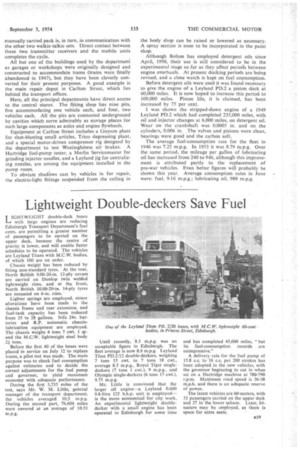Lightweight Double-deckers Save Fuel
Page 53

If you've noticed an error in this article please click here to report it so we can fix it.
LIGHTWEIGHT double-deck buses with large engines are reducing Edinburgh Transport Department's fuel costs, are permitting a greater number of passengers to be carried on the upper deck, because the centre of gravity is lower, and will enable faster schedules to be operated. The vehicles are Leyland Titans with M.C.W. bodies, of which MO are on order.
Chassis weight has been reduced by fitting Don-standard tyres. At the rear. North British 9.00-20-in. 12-ply covers are carried on Dunlop twin welded lightweight rims, and at the front, North British 10.00-20-in. 14-ply tyres are mounted on 6-in. rims.'
Lighter springs are employed, minor alterations have been made to the chassis frame and rear extension, and fuel-tank capacity has been reduced from 35 to 28 gallons. Nile 24v. batteries and R.P. automatic chassislubrication equipment are employed. The chassis weighs 4 tons 7 cwt. I qr. and the M.C:W. lightweight steel body 21 tons_ Before the first 40 of the buses were placed in service on July 12 to replace trams, a pilot test was made. The main purpose was. to check fuel consumption against estimates and to decide the correct adjustments for the fuel pump and governor, to yield maximum economy with adequate performance.
During the first 5,735 miles of the test, says Mr. W. M. Little, general manager of the transport department, the vehicles averaged 10.5 m.p.g. During the second part, 76,604 miles were covered at an average of 10.53 tn-P-g Until recently, 8.5 m.p.g. was an acceptable figure in Edinburgh. The fleet average is now 8.9 m.p.g. Leyland Titan PD.2/12 double-deckers, weighing 7 tons 15 cwt. to 7 tons 18 cwt., average 8.5 m.p.g., Royal Tiger singledeckers (7 tons 1 cwt.), 9 m.p.g., and Olympic single-deckers (6 tons 17 cwt.), 9.75 m.p.g.
Mr. Little is convinced that the larger oil engine—a Leyland 0.600 9.8-litre 125 b.h.p. unit is employed— is the more economical for city work. An experimental lightweight doubledecker with a small engine has been operated in Edinburgh for some time
and has completed 45,000 miles, "but its fuel-consumption records are unimpressive."
A delivery rate for the fuel pump of 15.8 c.c. to 16 c.c. per 200 strokes has been adopted in the new vehicles, with the governor beginning to cut in when set on a 14artridge machine at 780-790 r.p.m. Maximum road speed is 36-38 m.p.h. and there is an adequate reserve of power.
The latest vehicles are 60-seaters, with 33 passengers carried on the upper deck and 27 in the lower saloon. Later, 64seaters may be employed, as there is space for extra seats.




































































































